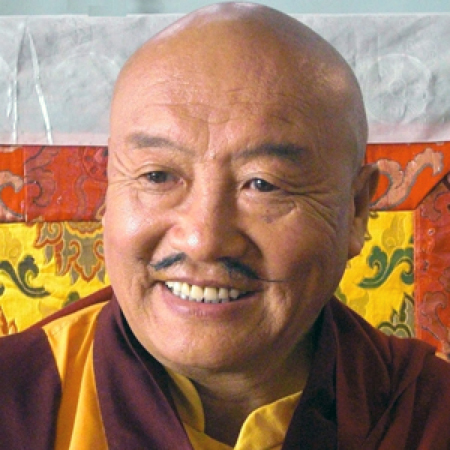My First Visit with Lamchen Gyalpo Rinpoche
In the summer of 2011 I had just finished ministering a wedding, while sitting at the dinner function following with another spiritual couple the conversation weaved in and out of various stories we shared on our search to find the truth. “I am looking for an advanced spiritual teacher?” I said to a new acquaintance Dr. Orest, of Homeopathy and acupuncturist. “ I know of one. He crossed the Himalayan Mountains he is a Tibetan Master.” For the first time in many years, since the days of Sivananda Yoga Retreats in the 80’s I felt a deep sense of excitement and longing to meet this Master.
One week later a meeting was arranged.
Lamchen Gyalpo Rinpoche of the Drikung Kagyu Lineage, “You must stand up when he walks in the room.”
I had already been 30 minutes late after being give a misinformed address and did not want to appear even more clumsy upon my first meeting with an auspicious leader of Tibet. Feeling stressed and tearful upon ringing the doorbell a young unpretentious man opened the door, “Do you have a GPS?”
“No” I replied feeling embarrassed and ashamed of my tardiness thus apologizing.
“You are smart!” he boastfully sounded, Khenpo Tenzin Nyima, a young monk welcomed. Immediately I felt at home with Khenpo Tenzin there was something familiar about him.
Orest and I were invited into a room with a picturesque window of a mirroring lake reflecting trees. Gliding on the calm water were two white graceful swans breaking the patterns of the trees and sky. The room was plain except for a photograph of a bearded elderly man appearing enlightened and a painted portrait of two distinguished looking Monks.
A strong masculine elderly man with a fierce mustache walked into the room. He sat down nodding his head acknowledging our presence as he crossed both of his legs underneath himself, unexpectantly his voice sounded sweetly kind unexpected for his physical stature. Orest bowed as did Khenpo Tenzin Nyima (Teacher of Tibetan Buddhist Philosophy) Nyima, given name meaning Sun.
Khenpo Tenzin Nyima translated into English from Tibetan for Venerable Lamchen Gylapo Rinpoche. My shoulders were burrowed up int o my ears with tension. Yet I was excited to meet a great teacher in hopes of receiving spiritual guidance.
I was dumb founded and felt pressured to give accurate clairvoyant visions!
Hearing myself stumble, “There is a very large woman with a horse and a spear around you, she has something round on top of her head.”
“What else? What will happen to Tibet?”
“I see an elephant pushing down a fence leading toward Tibet.”
Rinpoche, “Am I going to Tibet?”
The voice within my head echoed, “Not now — Just eat grapes.”
With earnest disconcerting effort Orest whispers to me, “Hush!”
In return Rinpoche raises one finger to quiet Orest.
With a bright smile Rinpoche questions, “What color grapes?”
My shoulders now implanted in my earlobes. Fumbling I reply, “Red”
Rinpoche breaks out into a warm hearted mischievous laughter as he rolls around on his hips.
Khenpo asks, “Now your questions for Rinpoche.”
Pulling out of my bag two pictures of my sons.
Conversation between the two Monks nodding in approval while looking at the pictures of Jon-Paul and Orion.
Khenpo Replies, “Rinpoche says both are good. Your younger son was a Monk in past life. He sees the good intention of your older son.”
“My youngest, Orion is 14 he stopped growing, his face is not changing. What should I do?”
Rinpoche, “only little bit of medicine.”
Conversation in Tibetan between Orest, Khenpo and Rinpoche continued. Deep respect for this man who led 500 of his people to escape from the Chinese Army in the 1950’s through the most difficult terrain on the earth known as the Roof of the World, Himalayan Mountains.
As the Tibetans attempted their escape out of their home land from the invasion of Chines occupation by Mao Zedong which began October 1949. Sadly 1.2 million Tibetans were killed at the hands of the Chinese Communistic Government. His Holiness the 14th Dalai Lama governed over Tibet largely a peaceful Buddhist Tradition without warfare to protect their country.
We all stand up and bow to Rinpoche as he leaves the room. The meeting is to the point, clear and over.
Khenpo leads the way upstairs to their meditation room.
Khenpo, “This is the woman with the horse and spear that you saw.” Pointing to a statute situated on an ornate large altar.
Achi Chokyi Drolma is the Dharma (Spiritual) Protectress (Dharmapala) of the Drikung Kagyu School of Tibetan Buddhism. Achi Chokyi Drolma is the grandmother of Jigten Sumgon, the founder of Drikung Kagyu, She also appears as a protector in the Karma Kagyu refuge tree as Achi Chodron and is a Dharmapala and Dakini in the life story of the Nyimgma Terton Tsasum Lingpa. (Wikipedia)
Losing my breath!
“Why did he ask those questions?”
Rinpoche came upstairs bounding with a beaming light expressing brightly and smiling gratefully speaking in broken English. “It took me 2 years to escape Tibet. Chinese army shot my brother and both of our horses. I got off my horse and walked. It took the Dalai Lama 6 weeks to cross over to India from Tibet he was closer!” With great enthusiasm Rinpoche smiled laughing, “I was father away so it took longer.”
This most amazing man seemed not to hold hatred nor bitterness toward the Chinese, he endured profound hardship and yet still carried an exuberance for life.
My own life issues were miniscal compared to Rinpoche’s experiences. I realized there was much to learn from this Great Scholar. It was a truly humbling to be in his presence.
Rinpoche and Khenpo authored a book of ‘Rinpoche’s story leading about 400 of my people out of Tibet.” Another warm-hearted laughter arose within this amazing man presence. His father was one of the king’s of Tibet.
Thus began my path with Rinpoche, Khenpo and Tibetan Buddhism.
Several weeks later another visit at the Gampopa Center. Khenpo Tenzin Nyima was standing in the kitchen. I asked curiously, “Will you be my teacher? Is there a book I can read?”
Gems of Dharma, Jewels of Freedom the classic handbook of Buddhism by Je Gampopa. At that precious moment Khenpo handed the book over to me.
Heading to Alaska with the book in hand intending to study and read, while in Alaska my adoring mother went into hospice care making her transition during my stay away.
Upon returning to NJ, I had asked Khenpo if I could take refuge ceremony with Lamchen Gyalpo Rinpoche. Before I knew it Orion and I found ourselves sitting in the meditation teaching room, with Rinpoche seated on his throne dressed in robe and high Buddha hat. Khenpo sat beside me instructing how to kneel, curl the toes fold hands in prayer and recite vows of, “In the Buddha, Dharma and Sangha I take refuge until all sentient beings attain enlightenment.”
Over the past 5 years my relationship with both Khenpo and Rinpoche deepened. They have proven to be Honorable Good Monks and teachers. Both have taught mediation and empowerments at The NJ Healing Center. As life would have it Khenpo came into my life at a crucial time when mym other was dying. His kind warm advice soothes away the burdens of daily living.
Needless to say Tibetan Buddhism does not normally prescribe to western medication however the advice given by Rinpoche was accurate in affecting my son’s health, he grew 3 inches needing only a “little medication”!
Grateful to Lamchen Gyaplo Rinpoche and Khenpo Tenzin Nyima.
Lindsey Sass
In honor of Lamchen Gyaplo Rinpoche Born Lamchen Gyalpo Rinpoche is recognized as an extraordinary scholar and practitioner possessing great realization of both Dzogchen and Mahamudra. He was uniquely qualified to transmit the Drikung Dzogchen teachings. Rinpoche was born in 1939 in the Nangchen region of eastern Tibet as the reincarnation of Lama Phurga (1883-1938). Lama Phurga was famous for his ability to see into a person’s past, present and future lives.
He has studied extensively with some of the greatest masters of Tibetan Buddhism.
He entered Parinirvana Sunday evening around 8:30pm EDT, 10/15/2017.
The Buddha assured all of the monks they would realize enlightenment. Then he said, All compounded things are subject to decay. Strive with diligence. Then, serenely, he passed into Parinirvana.
In Buddhism, the term parinirvana (Sanskrit: parinirvāṇa; Pali: parinibbāna) is commonly used to refer to nirvana-after-death, which occurs upon the death of the body of someone who has attained nirvana during his or her lifetime. (Wikipedia)


Recent Comments